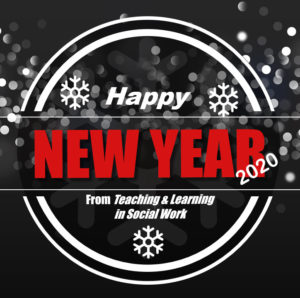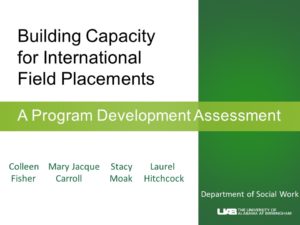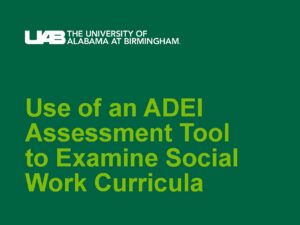Use of an ADEI Assessment Tool to Examine Social Work Curricula
On October 25, 2024, during the Annual Program Meeting for the Council on Social Work Education in Kansas City, MO, my UAB colleagues (Colleen Fisher, Mary Jacque Carroll and Ron Pitner) and I presented an assessment tool developed by Melissa Freedman, MSW, to review syllabi and courses as an effort to ensure the integration of antiracism, diversity, equity, and inclusion (ADEI) within our program curricula at the University of Alabama at Birmingham’s Department of Social Work. We used this tool to assess course content in our Bachelor’s, Master’s and Field Education courses. In this blog post, we provide access to the tool and slides from the presentation.
Pinterest Assignment for the Social Work Classroom

A few years back, my colleague, Dr. Lisa Baker at Samford University’s Department of Social Work, and I collaborated on a study about a technology-meditated assignment that we developed for a Human Behavior and the Social Environment (HBSE) course. Our goal was to breathe some new life into a stale assignment. In this post, I want to share how we approached the development, assessment, and dissemination of our study related to this tech-mediated assignment.
Using Twitter at a Professional Conference
Editor’s Note: This post is one in a series about how technology can be used to develop and sustain one’s professional network. The idea for this post came from a think tank hosted by the University at Buffalo’s School of Social Work in June 2019, looking for a way to teach students in their new online Doctorate of Social Program (DSW) program about how to develop key stakeholder networks in relation to a substantive topic area. In this series, we are exploring the concept of a Professional Collaboration Network (PCN), which are technology-mediated user-centered relationship constellations designed to enhance or enrich connections, knowledge, and professional opportunities. This post covers the use of Twitter at professional conferences as a way to share your insights and extend the reach of the conference sessions.
This is the fourth blog post in a series on using Twitter to create Professional Collaboration Networks (PNCs). Previous posts included:
- What is a Professional Collaboration Network (PCN) & why do you need one?
- Twitter for your Professional Collaboration Network (PCN)
- How do you do relational Twitter?: Developing your Professional Collaboration Network

In this blog post, we discuss how Twitter can be used at a professional social work conference. There are at least two important reasons why tweeting at conferences is a valuable practice. First, attending conferences requires resources and time. Not everyone has the ability to attend all conferences, and one person certainly cannot attend all of the conferences that interest them. By tweeting from a conference, participants can share what they learned in sessions with anyone who is interested. Not only does this extend the reach of the knowledge shared at a conference, it makes content accessible to individuals and groups who might not be able to attend. Curating all the tweets from a conference can create an informal transcript of the happenings at a conference from multiple points of view. Second, tweeting at a conference allows an individual another way to network and meet people. Creating a public list of individuals and groups on Twitter who are attending the conference can supplement a stack of business cards and allow you to engage with more people during and after the conference. Alternatively, if you can’t attend a conference, you can follow the tweets of users who are at the conference and reply with your questions. There are even some conferences that occur only on Twitter (check out @Biotweeps).Third, it can increase your visibility in a particular subject area. For example, if you are presenting at the conference, you have the opportunity to share a photo and information from your session. The suggestions in this post come from the real life experiences of the authors as well as recommendations gleaned from articles written about conference tweeting.
Review of Teaching & Learning in Social Work for 2019

It is that time of year again – the annual review of the Teaching & Learning in Social Work Blog. This will be my fourth year reflecting on the work of this blog; the first end of the year post was in 2016. This year, I am thinking more about my motivation for starting and maintaining this blog for the past seven years. As I think back on why I started Teaching & Learning in Social Work, I’d have to say I wanted to be a more confident writer. Academic writing is not easy. This blog helped me to find my academic voice while allowing me to experiment with writing. I try to be personable in the posts I write, using plain language and concise phrasing. While I can say I am more comfortable with my professional writing, the greatest benefit to this blog is having space to share my work and the work of others in a very non-traditional space. Publishing is a peer-reviewed journal is currency for academics, and it is a narrow, rigid, and polished way to share one’s work. By writing blog posts about my work early in the process, I can share with a wider audience including students, social work practitioners and professionals from other fields. I can also as publish work that may never find a home as a journal article, but is still of value to others. For example, I write frequently about my assignments and classroom activities on this blog. I also post information about my conference presentations here so others can easily reference the materials. Overall, I can say with confidence that writing and publishing Teaching & Learning in Social Work has truly be beneficial and motivating for my academic writing.
For 2019, I had three goals for improving the blog:
#APM19 – Building Capacity for International Field Placements: A Program Development Checklist

Are you attending the Council on Social Work Education’s Annual Program Meeting in Denver this week? Want to know more about how to do an international social work field placement? Do you need a session to attend on Friday, October 25th at 7:30 AM? Well, then we have a session for you. Please consider attending the panel discussion about the ongoing development for our international field placement checklist; which I am doing with my good colleagues from the Department of Social Work at the University of Alabama at Birmingham. Colleen Fisher, Mary Jacque Carroll, Stacy Moak and I will talk about how the key benefits, challenges, and social justice considerations of developing new international field placement, and review our checklist which is in the early stages of development. Overall, our goals is to share our capacity building strategies for international placements through a practical checklist designed for social work.
For those of you who cannot make the presentation, we are including some details in this blog post. First, here are some screen shots of our checklist:
#APM19 – Evolving the Signature Pedagogy with the Social Media Toolkit for Field Educators

On October 27, 2019 at 8:45 AM, during the Annual Program Meeting for the Council on Social Work Education in Denver CO, Mary Jacque Carroll, Allison M. Curington, Robyn V. Snider and I will be presenting on information and tools that field directors can use to guide curricular development and assessment strategies around interprofessional communication with digital and social technologies. If you are still in Denver, please come find us in Governor’s Square 11 – Plaza Building of the conference hotel. We’ll also be sharing how you can develop your own professional social media policies to support communication with students and field agencies as well as how to create activities for students in field to increase understanding of the ethical use of social and digital media in social work practice.
You’ll also learn how to access the Social Media Toolkit for Field Educators, a free resource with educator’s guide and a PowerPoint slide deck.



